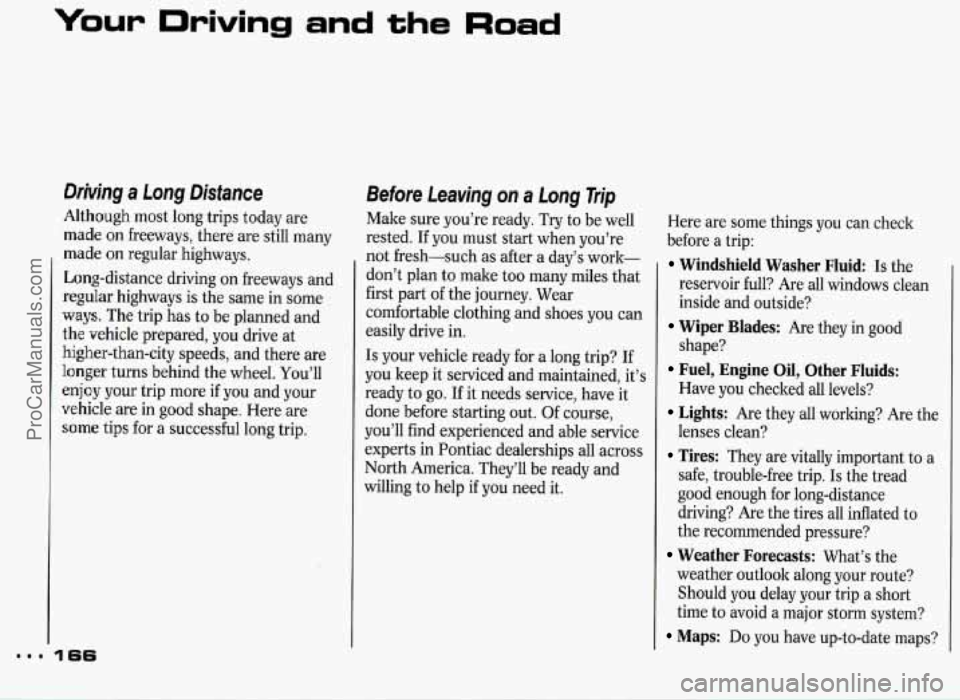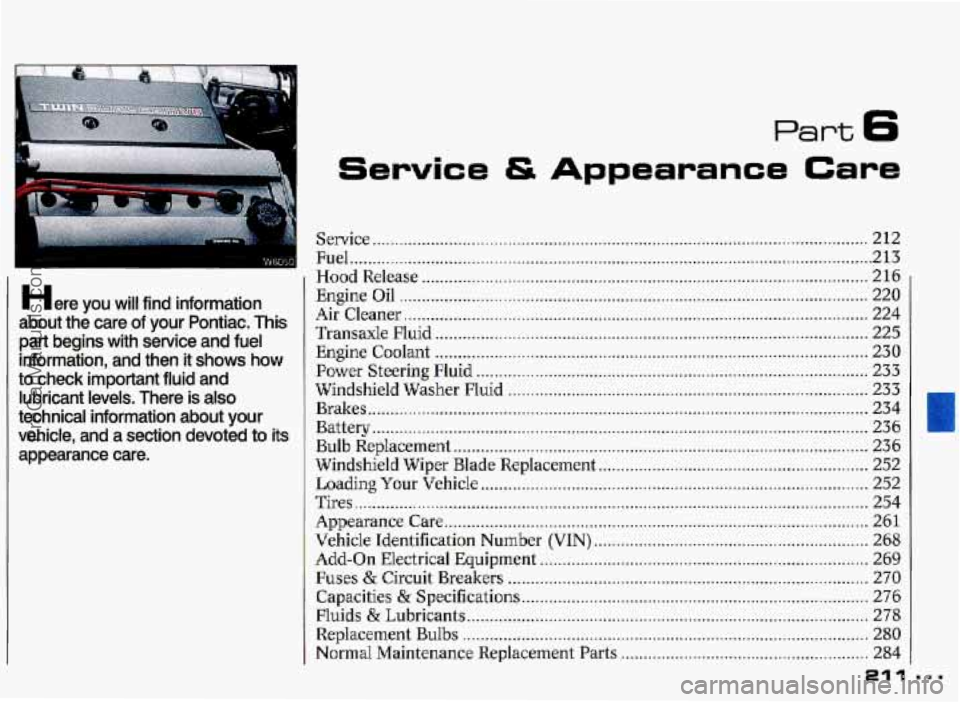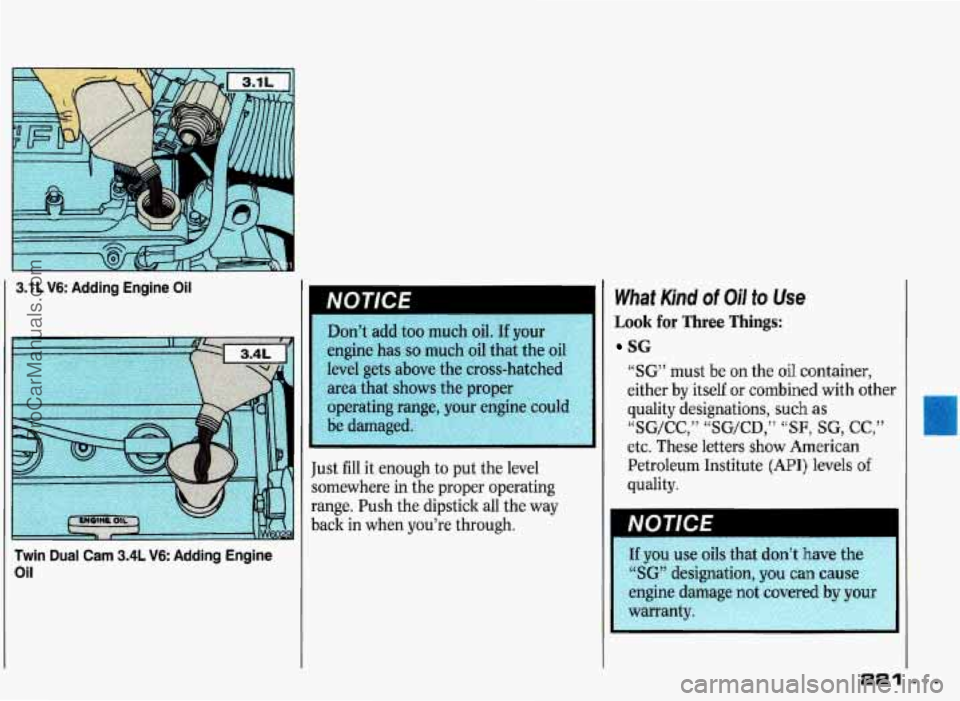1993 PONTIAC GRAND-PRIX oil level
[x] Cancel search: oil levelPage 167 of 338

Your Driving and the Road
Drkjng a Long Distance
Although most long trips today are
made on freeways, there are still many
made
on regular highways.
Long-distance driving on freeways and
reguIar highways is the same in some
ways. The trip has to be planned and
the vehicle prepared, you drive at
higher-than-city speeds, and there are
longer turns behind the wheel. You’ll
enjoy your trip more if you and your
vehicle are in good shape. Here are
some tips for a successful long trip.
Before Leaving on a Long Trip
Make sure you’re ready. Try to be well
rested. If you must start when you’re
not fresh-such as after a day’s work-
don’t plan to make too many miles that
first part of the journey. Wear
comfortable clothing and shoes you can
easily drive in.
Is your vehicle ready for a long trip? If
you keep it serviced and maintained, it’s
ready to go. If it needs service, have it
done before starting out. Of course,
you’ll find experienced and able service
experts in Pontiac dealerships all across
North America. They’ll be ready and
willing to help
if you need it. Here
are some things you can check
before a trip:
Windshield Washer Fluid Is the
reservoir full? Are all windows clean
inside and outside?
shape?
Have you checked all levels?
lenses clean? safe, trouble-free trip.
Is the tread
good enough for long-distance
driving? Are the tires all inflated to
the recommended pressure?
weather outlook along your route?
Should
you delay your trip a short
time to avoid a major storm system?
Maps: Do you have up-to-date maps?
Wiper Blades: Are they in good
Fuel, Engine Oil, Other Fluids:
Lights: Are they all working? Are the
Tires: They are vitally important to a
Weather Forecasts: What’s the
ProCarManuals.com
Page 196 of 338

The coolant level should be at or above
the
COLD mark. If it isn’t, you may
have a leak in the radiator hoses, heater
hoses, radiator, water pump or
somewhere else in the cooling system.
~ CAUTION
A
Heater and radiator hoses,
and other
engine parts, can
be very hot. Don’t touch them. If
you do, you can be burned.
Don’$ run the engine if there is a
leak. If you run the engine, it could
lose all coolant. That could cause
an engine fire, and you could be
burned. Get any leak fixed before
I vou drive the vehicle.
If there seems to be no leak, check to
see if the electric engine fan is running.
If the engine is overheating, the fan
should be running. If it isn’t, your
vehicle needs service.
How to Add Coolant to the Coolant
Recovery Tank:
If you haven’t found a problem yet, but
the coolant level isn’t at or above
COLD, add a 50/50 mixture of clean
water (preferably distilled) and a proper
antifreeze at the coolant recovery tank.
(See the
Index under Engine Coolant
for more information about the proper
coolant mix.)
A
Adding only plain water to
your cooling system
can be
dangerous. Plain water,
or some I
other liquid like alcohol, can boil
before the proper coolant
mix will.
Your vehicle’s coolant warning
system
is set for the proper coolant
mix. With plain water or the wrong
mix, your engine could get too hot
but you wouldn’t get the overheat
warning. Your engine could catch
fire and
you or others could be
burned. Use a
50/50 mix of clean
water and a proper antifreeze.
cold weather, water can free-
d crack the engine, radiatnr
ater core and other parts.
ProCarManuals.com
Page 212 of 338

Part 6
Here you will find information
about the care
of your Pontiac . This
part begins with service
and fuel
information. and then it
shows how
to check important fluid and lubricant levels
. There is also
technical information about your
vehicle. and a section devoted
to its
appearance care
.
81 1
Service & Appearance Care
Service ........................................................................\
...................................... 212
Fuel ........................................................................\
............................................ 213
Hood Release ........................................................................\
............................ 216
Engine Oil
........................................................................\
................................ 220
Air Cleaner ........................................................................\
............................... 224
Transaxle
Fluid ........................................................................\
........................ 225
Engine Coolant ........................................................................\
........................ 230
Power Steering Fluid ........................................................................\
............... 233
Windshield Washer
Fluid ........................................................................\
........ 233
Brakes
.......... .......................... ........................................................................\
... 234
Battery
........................................................................\
........................ .... .......... 236
Bulb Replacement ........................................................................\
.................... 236
Loading
Your Vehicle ........................................................................\
.............. 252
Vehicle Identification Number (VIN) ............................................................. 268
Capacities
& Specifications ........................................................................\
..... 276
Replacement
Bulbs ................................................................... .......- ............... 280
Windshield Wiper
Blade Replacement ............................................................ 252
Tires ........................................................................\
.......................................... 254
Appearance Care ........................................................................\
...................... 261
Add-on Electrical Equipment ........................................................................\
. 269
Fuses & Circuit Breakers ........................................................................\
........ 270
Fluids
& Lubricants ........................................................................\
................. 278
Normal Maintenance Replacement Parts ....................................................... 284
ProCarManuals.com
Page 215 of 338

...
Service 4S Appearance Care
Gasolines for Cleaner Air
Your use of gasoline with detergent
additives will help prevent deposits
from forming in your engine and fuel
system. That helps keep your engine in
tune and your emission control system
working properly. It’s good for your
vehicle, and you’ll be doing your part
for cleaner air.
Many gasolines are now blended with
materials called oxygenates. General
Motors recommends that you use
gasolines with these blending materials,
such
as MTBE and ethanol. By doing
so, you can help clean the air, especially
in those parts of the country that have
high carbon monoxide levels.
214
In addition, some gasoline suppliers are
now producing reformulated gasolines.
These gasolines are specially designed
to reduce vehicle emissions. General
Motors recommends that
you use
reformulated gasoline. By doing
so, you
can help clean the air, especially in
those parts
of the country that have
high ozone levels.
You should ask your service station
operators
if their gasolines contain
detergents and oxygenates, and
if they
have been reformulated to reduce
vehicle emissions.
Fuels in Foreign Countries
If you plan on driving in another
country outside the
U.S. or Canada,
unleaded fuel may be hard to find.
Do
not use leaded gasoline. If you use even
one tankful, your emission controls
won’t work well or at all. With
continuous use, spark plugs can get
fouled, the exhaust system can corrode,
and your engine oil can deteriorate
quickly. Your vehicle’s oxygen sensor
will be damaged. All of that means
costly repairs that wouldn’t be covered
by your warranty.
ProCarManuals.com
Page 221 of 338

Service & Appearance Care
Eagine Oil
It’s a good idea to check your engine oil
every time you get fuel.
In order to get
an accurate reading, the oil must be
warm and the vehicle must be on level
ground. Turn
off the engine and give
the oil a few minutes to drain back into
the oil pan.
If you don’t, the oil dipstick
might not show the actual level.
To Check Engine Oil:
Pull out the dipstick and clean it with a
paper towel or cloth, then push it back
in all the way. Remove it again, keeping
the tip lower.
3.1 L V6: Checking Engine Oil
Twin Dual Cam
3.4L V6: Checking Engine
Oil
When to Add Oil:
If the oil is at or below the ADD line,
then you’ll need to add some
oil. But
you must use the right kind. This
section explains what kind
of oil to use.
For crankcase capacity, see the
Index
under Capacities and Specifications.
ProCarManuals.com
Page 222 of 338

3.1 L V6: Adding Engine Oil
Twin
Dual Cam 3.4L V6: Adding Engine
Don’t add too much oil. If y
Just fill it enough to put the level
somewhere in the proper operating
range. Push the dipstick all the way
back in when you’re through.
What Kind of Oil to Use
Look for Three Things:
SG
“SG” must be on the oil container,
either by itself
or combined with other
quality designations, such
as
“SG/CC,” “SG/CD,” “SF, SG, CC,”
etc. These letters show American
Petroleum Institute (API) levels of
quality.
u use oils that don’t
have th
” designation, you can caus
221
ProCarManuals.com
Page 226 of 338

2. Remove the air cleaner filter.
3. Be sure to install the air cleaner filter
and replace the cover tightly.
Automatic Transaxle Fluid
When to Check and Change:
A good time to check your automatic
transaxle fluid level
is when the engine
oil is changed. Refer to the Maintenance
Schedule to determine when to change
your fluid. See the
Index under
Scheduled Maintenance Services.
How to Check:
Because this operation can be a little
difficult, you may choose to have this
done at a Pontiac dealership Service
Department.
If you do
it yourself, be sure to follow
all the instructions here, or you could
get a false reading on the dipstick.
NOTICE I
00 much or too little fluid
mage your transaxle.
Too
n mean that some of the flu
Id come out and fall on
ho
ine parts, starting a fi
I
225 . .
ProCarManuals.com
Page 229 of 338

Service & Appearance Care
Manual Pransaxle Fluid
When to Check:
A good time to have it checked is when
the engine oil is changed. However, the
fluid in your manual transaxle does not
require changing.
How to Check:
Because this operation can be a little
difficult,
you may choose to have this
done at a Pontiac dealership service
department.
If you do it yourself, be
sure
to follow all the instructions here,
or YQU could get a false reading on the
dipstick.
’. 22%
00 little fluid can
amage your transaxle.
Too much
an mean that some of the fluid
ould come out and fall on hot
ngine parts, starting a fire. Be
ure to get
an accurate reading if
ou check your transaxle fluid. The manual
transaxle dipstick is located
on the driver’s
side near the rear of the
transaxle case.
Check the fluid level
only when your
engine is
off, the vehicle is parked on a
level place and the transaxle is cool
enough for
you to rest your fingers on
the transaxle case.
Then, Follow These Steps:
1. Flip the handle up and then pull out
the dipstick and clean it with
a rag or
paper towel.
remove it.
2. Push it back in all the way and
ProCarManuals.com